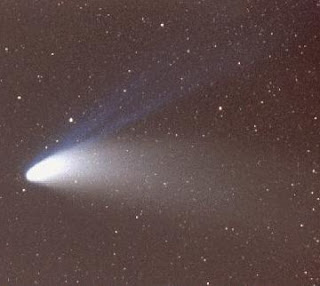Astrophotos Through 2 Inch Lenses
This page presents examples of astro-photography through a 2" (50mm) lens. Photographs displayed on this page were taken with small telescopes and telephoto lenses no bigger than two inch aperture. The Moon and Sun pictures were taken through a 2 inch f/15 telescope made with a Jaegers optics objective. The comet photographs were taken with an SLR 35mm camera mounted piggy back on a 6" Newtonian that had a clock drive. The camera was fitted with a 135 mm lens.
Jaegers Optics for decades was a supplier of superb government surplus optics and other supplies that amateur astronomers used. Through Jaegers one could obtain all the parts to make great telescopes, including the tubing, lenses, focusers, telescope tubes, mirrors, and mirror mounts. The 50mm Jaegers I have is one made from that supply chain back when it was still in operation.
All of the pictures on this page except the Solar ones were taken with conventional 35mm film. The Solar images were taken with a modified Quickcam Express webcam. I used SLR cameras (Single Lens Reflex) because I could remove the lens easily. My particular models are an Exa II, a Pentax K1000, and a Zenit. The Exa's are no longer made but are still around. A good yet inexpensive alternate choice would be a Zenit. These cameras have just enough capability (both are SLR's), yet are simple and inexpensive.
For piggyback photography (camera with telephoto mounted aside telescope) any camera would do, but SLR's make it easy to substitute a telephoto lens for the regular lens. A time exposure with a guided camera without a telephoto will record stars well below what you can see, but it will also show a very large field, even in excess of entire constellations.
The photographs of the Moon and planets on this page were created by replacing the lens with an adaptor that is just a 1.25" snout. This snout fits into a standard 1.25" focuser, making mounting of the camera easy.
The books I'm familiar with on this subject are Skyshooting by the R. Newton and Margaret Mayall, and George T. Keene's Star Gazing with Telescope and Camera. Neither are new, but both describe well how to use conventional film cameras to get great photographs.
Now-a-days, I would still recommend film cameras for inexpensive star photography. The reason is that star object photography requires time exposures of at least a few minutes long. It costs considerably to get a DSLR (digital single lense reflex) that can take time exposures that long. For Lunar and Planetary, I like digital, because many images can be collected in a "movie" mode, and a computer can be used to average many images, which helps reduce the effects of seeing.
Images Through 2 Inch Lenses
Load images in another tab for larger view
Hale Bopp comet, EXA slr, 135mm Telephoto, 800 ASA Film, 5 Min Exposure.
Moon Image, Plato Region, 2 Inch Jaegers f/15 Refractor, EXA slr, Plus X Film, Barlow Projection.
Moon Image, Apennine Mountains, 2 Inch Jaegers f/15 Refractor, EXA slr, Panatomic X, Barlow Projection.
Moon Image, South Polar Region, 2 Inch Jaegers f/15 Refractor, EXA slr, Panatomic X, Barlow Projection.
Moon Image, Alphonsus Region, Waxing Moon, 2 Inch Jaegers f/15 Refractor, EXA slr, Panatomic X, Barlow Projection.
Moon Image, Alphonsus Region, Waning Moon, 2 Inch Jaegers f/15 Refractor, EXA slr, Plus X, Barlow Projection.
Sun Image, Annular Eclipse of 1994. Hand-held Polaroid SX70 Through 2 Inch
Jaegers f/15 Refractor projected onto a screen. What appear to be smudges on the right-most image are sunspots.
Sun Image, Mercury Transit: November 8, 2006. Hand-held digital camera looking through 2 inch Jaegers f/15 refractor that had a mylar sun filter. Mercury is the small dot just into the lower left quadrant. Load into another tab to expand the view.
Venus Transit, June 5, 2012. Afocal photo through 2 inch f/15 refractor that had a mylar sun filter.
I used 400 ASA B/W film and a 35mm Pentax K. The large dot in lower right quadrant is Venus. A number of sunspot groups are
also visible in the photo. Recall that Venus is about the size of earth. The photo gives a good sense of how much bigger the sun is that earth.









No comments:
Post a Comment